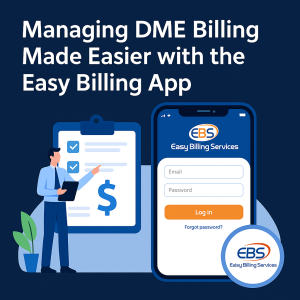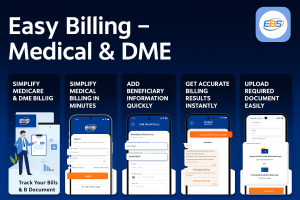If you’re stepping into the world of healthcare billing, credentialing, or setting up your practice or business, you’ve probably heard of NPI numbers. But here’s where things get tricky. Because there are actually two types, and while both seem similar on paper, they serve very different purposes.
So let’s walk through this in a way that makes sense, without the jargon or overly technical detours. We’re going to clear the fog surrounding NPI Type 1 vs Type 2, figure out which one you need, and why making the right choice can make or break your medical billing and reimbursement process.
What Even Is an NPI Number?
NPI stands for National Provider Identifier, a unique 10-digit number assigned by the Centers for Medicare & Medicaid Services (CMS). This number is used to identify healthcare providers across the United States in all kinds of administrative transactions, whether it’s billing, credentialing, or working with insurance payers.
It acts as a digital fingerprint for providers, ensuring that your identity is recognized consistently, no matter where or how you’re practicing. But here’s where things get a little more detailed: there isn’t just one type of NPI. There are actually two, and that’s where the confusion often begins. Understanding the difference between NPI Type 1 vs Type 2 is crucial because choosing the wrong one can disrupt everything from claim processing to reimbursement timelines.
Whether you’re an individual healthcare provider or running a full-fledged clinic, knowing how NPI Type 1 vs Type 2 applies to your specific situation is key to staying compliant and efficient.
Sounds straightforward, right?
Well, not quite. Because there are two different types:
- NPI Type 1: This is for an individual healthcare provider NPI. Think doctors, nurses, physical therapists, chiropractors, and anyone who personally provides care.
- NPI Type 2: This is for organizations. Think hospitals, clinics, group practices, or any business that provides healthcare services.
And that’s where the confusion begins.
NPI Type 1 vs Type 2: Let’s Break It Down
Here’s a simple comparison:
| Criteria | NPI Type 1 | NPI Type 2 |
| Who Gets It | Individual providers | Healthcare organizations or businesses |
| Example | Dr. Smith, an individual practitioner | Smith Family Clinic, LLC |
| Required For | Credentialing, individual claims | Billing for group or facility services |
| Linked To SSN or EIN? | SSN (Social Security Number) | EIN (Employer Identification Number) |
| Can One Person Have Both? | Yes | Yes |
You can absolutely have both if you’re a solo practitioner running a business. You’ll use your Type 1 NPI when billing as an individual and your Type 2 NPI when billing as your company or organization.
Why Choosing the Right NPI Type Actually Matters
If you’re sending out claims to insurance or Medicare and using the wrong NPI type, you’re inviting headaches. Rejected claims. Delayed reimbursements. Confused payers.
Imagine being a DME supplier in California and submitting claims under your individual NPI (Type 1) when you’re actually operating under an LLC. You’re not only risking non-payment but potentially setting yourself up for compliance issues.
Here’s why the NPI Type 1 vs Type 2 decision is critical:
- It determines how you’re credentialed.
- It affects who gets paid.
- It dictates how your contracts are set up.
If you’re a provider thinking of starting your clinic, you’ll need to plan this out carefully from the start.
NPI Types and Credentialing Essentials for Doctors
Credentialing is where a lot of the confusion hits. If you’re a solo provider, credentialing under your Type 1 NPI makes sense. But what if you’re operating under a business name or a group?
That’s where the Type 2 NPI kicks in.
When insurance payers credential your group or clinic, they’re credentialing your Type 2 NPI. But when they credential you personally as the treating provider, that’s your Type 1.
And yes, you can, and often should, have both.
Real-Life Example: A DME Billing Scenario
Let’s say you’re a DME provider working out of California. You’ve set up shop legally, filed for an LLC, and are ready to go. You need to:
- Apply for your NPI Type 2 as an organization.
- Get credentialed with Medicare and private payers under that business NPI.
- Then, apply for your Type 1 NPI as the individual responsible for care or oversight.
This structure ensures your DME billing services in CA run smoothly, and claims are routed properly.
The Contracts and Billing Connection
The type of NPI you use directly influences your contracts. If you have contracts for medical billing services, they may need to list your Type 2 NPI, especially if the agreement is with your business entity.
For solo providers without an established company, it’s your Type 1 that will appear on contracts and forms. And when it comes to the cost of medical billing services, it often varies depending on whether you’re billing under an individual or organizational model.
However, when billing under a Type 2 NPI, you’re representing an organization, such as a clinic, group practice, or DME supplier, which usually involves a higher claim volume, multiple providers, more complex insurance contracts, and added administrative layers. All of this can impact the cost structure. Billing companies often charge a higher percentage for Type 2 setups due to the increased coordination, compliance requirements, and processing complexity involved. Understanding this distinction between NPI Type 1 vs Type 2 can help you better evaluate and negotiate your billing service agreements.
For instance, medical billing company percentage rates can vary significantly depending on whether you’re operating under a Type 1 or Type 2 NPI setup. When billing under a Type 1 NPI, you’re usually working as a solo provider, which often means lower patient volume, fewer claims, and a more straightforward billing structure. In such cases, the billing percentage may be lower because the workload is more predictable and easier to manage.
So, Which One Do You Really Need?
Let’s simplify:
- Solo doctor working independently? Get Type 1.
- Running a business, clinic, or group? You’ll need Type 2.
- Doing both? Get both. It’s common, smart, and keeps your operations clean.
Remember, payers care about this. Your credentialing team cares. Your billing company cares.
When you’re setting up credentialing, negotiating contracts, or choosing a DME billing company in CA, this question of NPI Type 1 vs Type 2 will be front and center.
In Conclusion
The divide between NPI Type 1 vs Type 2 isn’t just technical red tape. It’s the foundation for everything that follows in your healthcare career, from how you bill, to how you’re paid, to how your patients receive care.
Getting this wrong could slow down your payments or put you in legal hot water. Getting it right means cleaner claims, fewer denials, and faster reimbursements.
Clarity matters. And whether you’re new to this or simply reassessing your setup, one truth remains: Understanding your NPI types is non-negotiable.
Easy Billing Services LLC® has helped hundreds of providers, from solo practitioners to large DME suppliers, understand, apply for, and manage the correct NPI structure. When providers get this part right, everything else falls into place.Still unsure whether you need type 1 vs type 2 NPI? Don’t leave your billing and reimbursements up to guesswork. Let our experts walk you through the right setup for your practice or DME business. Reach out to Easy Billing Services LLC® today at 877-306-2906 or email us at info@easybillingservices.com. We’re here to help you get it right from the start.









